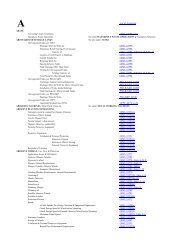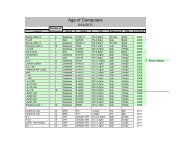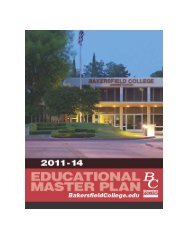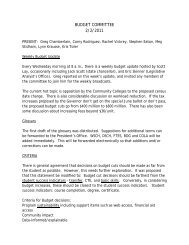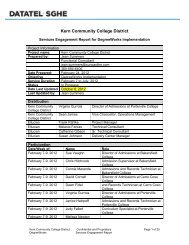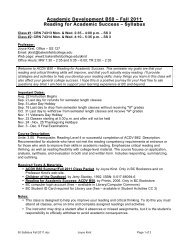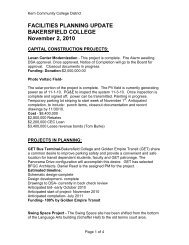Addendum with evidence (8.2 MB) - Accreditation - Bakersfield ...
Addendum with evidence (8.2 MB) - Accreditation - Bakersfield ...
Addendum with evidence (8.2 MB) - Accreditation - Bakersfield ...
Create successful ePaper yourself
Turn your PDF publications into a flip-book with our unique Google optimized e-Paper software.
1. Increase college and career readiness<br />
2. Strengthen support for entering students<br />
3. Incentivize successful student behaviors<br />
4. Align course offerings to meet student needs<br />
5. Improve the education of basic skills students<br />
6. Revitalize and re-envision professional development programs<br />
7. Enable efficient statewide leadership and increase coordination among colleges<br />
8. Align resources <strong>with</strong> student success recommendations<br />
Some of these recommendations require changes to State law and regulations. Others require<br />
new resources. The rest can be accomplished in each community college district that has the will to<br />
do so <strong>with</strong>out either of these state-level changes. Two of the Task Force recommendations already<br />
have been passed into law. They include creating a common assessment/placement system and<br />
providing electronic transcripts. Assembly Bill 743, supporting the common assessment tests, has<br />
received a one-time allocation of $500,000. Those public funds will be combined <strong>with</strong> Gates and<br />
Hewlett Foundation grant funding to total $850,000 for start-up costs beginning in January 2012.<br />
Assembly Bill 1056, supporting the introduction of electronic transcripts, has also received a onetime<br />
allocation of $500,000 to help fund the cost of converting from paper to an electronic transcript<br />
system. The ongoing maintenance expenses for an electronic transcript system are anticipated to be<br />
covered by the savings generated by the use of the more efficient electronic system.<br />
The Task Force recommendations come in the wake of a severe shortfall in resources for the<br />
State’s public higher education institutions. Fiscal support to the community colleges has been<br />
sharply curtailed in recent years. As noted above, the prospects for a quick recovery to the state’s<br />
economy and ability to support higher education are not good. The Legislature has increased the<br />
enrollment fee that students pay from $26 per unit to $36 per unit and they will likely increase it<br />
again in the near future. Governing boards for the University of California and the California State<br />
University systems have also responded to reduced State support by increasing their tuition fees.<br />
Both university systems are reducing the number of students that are accepted and redirecting many<br />
to the community colleges. The community college system is overwhelmed <strong>with</strong> enrollment. As a<br />
result, class sections, which have been reduced in number, fill quickly causing students to take more<br />
time to earn their degrees.<br />
Although not a higher education policy, a shift in instructional strategy by the Kern Union<br />
School District may have an effect on future enrollments at the College. In 2009, the Board adopted<br />
a policy to develop a system of pathways and changed graduation requirements. Each student must<br />
select college preparatory, career education of an approved individual pathway. The policy change<br />
shifts the District from a culture of “college going for all students” to a culture of “lifelong learning.”<br />
The goal is to better prepare high school graduates for entering the workplace or for beginning a<br />
college education. This initiative may present the College <strong>with</strong> opportunities for “tech-prep”<br />
agreements.<br />
Key Demographic Considerations<br />
Demographic attributes for the County and State are provided in the table below. It is<br />
notable that, for Kern County, the projected percentage of increase in population between the year<br />
2000 and 2015 (34%) is more than twice that of the State. The projected change in per capita income<br />
between the year 2000 and 2015 is 7% below the State percentage.<br />
24



